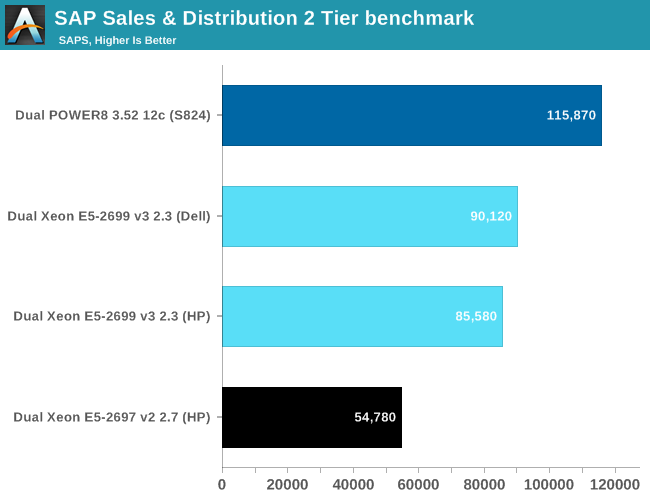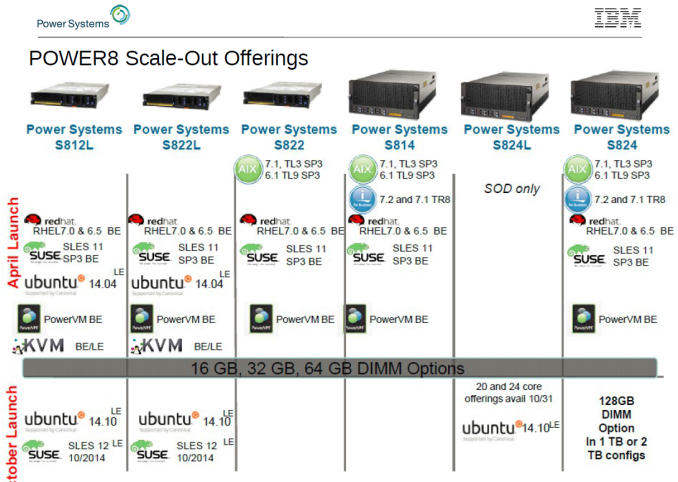The IBM POWER8 Review: Challenging the Intel Xeon
by Johan De Gelas on November 6, 2015 8:00 AM EST- Posted in
- IT Computing
- CPUs
- Enterprise
- Enterprise CPUs
- IBM
- POWER
- POWER8
Reading the Benchmarks
There are a lot of benchmarks available that compare the IBM POWER8 to Xeons. One example is the Enterprise Resource Planning (ERP) software SAP. We have used the Sales & Distribution 2 Tier benchmark many times because it is one of the very few benchmarks that is a very good representation of real world high-end enterprise workloads.

Now combine this with the benchmarks that IBM has compiled on their marketing slides and the fact that we know that the POWER8 chip has a TDP of 190W at nominal speed and 247W when running at "Turbo" clockspeeds.
It all seems very simple: the IBM POWER8 is a more power hungry chip but delivers much better performance. But as always you should take the time to read the benchmarks very closely. The IBM S824 is typically the one featured in the benchmarks. However, we are pretty sure that is not the system that will be able to sway the current Intel Xeon customers towards OpenPOWER. Nor are we convinced that the most widely reported benchmarks are accurately predicting the experience of those people.
There are three reasons for that. First of all, most of the benchmarks are run on AIX (7), IBM's own proprietary UNIX. AIX is a high performance, extremely robust OS, but it does not have the rich software system and support that Linux has. Furthermore even with their common design elements, an excellent Linux administrator will have to invest some time to get the same level of expertise in AIX. But more importantly, the S824 is a pretty expensive machine, both in acquisition cost (starting at $21.000, up to $60.000 and more) and energy cost. That kind of pricing lands the system in hostile and more powerful quad Xeon E7 territory.
Lastly, the S824 uses two CPU cards or Dual Chip Modules (DCM), each containing two six-core POWER8 modules at 3.5 GHz. Now consider that the third party OpenPOWER servers have 190/247W TDP 10-core 3.4 GHz POWER8 CPUs. The power consumption does not increase linearly as you add more cores and higher clocks. So the CPU modules found inside the S824 are definitely more power hungry, probably well above 250W.
There is more. Take a look at IBM "Scale-out" server, the more affordable server range of IBM servers. First, a bit of IBM server nomenclature which is actually quite logical and easy to decipher (take note, Intel marketing).
- S stands for "Scale-out"
- 8 stands for POWER8
- 1 or 2 is the number of sockets
- 2 or 4 is the height, expressed in rack Us.
So an S824 contains 2 sockets in a 4U chassis and a S812 is a one socket system. There is one designation left, : the "L" or Linux .
Notice that the non-L versions also support Linux, but a few months ago they supported only the Big Endian (BE) versions (the slide is from the beginning of this year). IBM told us that all POWER8 servers now support both Little Endian (LE) and BE Linux.
This is important since using an LE version (Ubuntu, SUSE) makes data migration from and data sharing (NAS, SAN) with an x86 system much easier, as x86 only supports LE.












146 Comments
View All Comments
extide - Friday, November 6, 2015 - link
No he meant that in a lot of the european countries they use the dot as a comma, so it would be 50.000 to mean 50 thousand.Murloc - Sunday, November 8, 2015 - link
the international system dictates that , and . are the same thing, and as a separator you should use a space.In many countries in Europe, ' is also used. That's fine too as there is no ambiguity.
Using . and , for anything that is not the decimal separator in international websites just creates confusion imho.
I guess AT doesn't have a style book though.
duploxxx - Friday, November 6, 2015 - link
nice review.but Xeon is not 95% of the market. AMD is still just a bit above 5% on its own. so it deserves a bit salt :) not to mention the fact that competition is good for all of us. if reviewers continue like this all narrowed readers will think there is no competition.
silverblue - Friday, November 6, 2015 - link
I'm left wondering what a Steamroller-based 16+ core CPU would do here, considering multithreading is better than with previous models. Yes, the Xeons have a large single-threading lead, but more cores = good in the server world, not to mention that such a CPU would severely undercut the price of the competition.Shame it isn't ever going to happen!
lmcd - Friday, November 6, 2015 - link
Or even an Excavator! It's a shame AMD didn't just keep Bulldozer developing internally until at least Piledriver, and iterate on Thuban.Kevin G - Saturday, November 7, 2015 - link
AMD killed off both Streamroller and Excavator chips early on as the Bulldozer and Piledriver chips weren't as competitive. More importantly, OEMs simply were not interested even if those parts were upgrades based upon existing designs. Thus the great AMD server drought began as they effectively have left that market and are hoping for a return with Zen.Also I should point out that Seattle, AMD's first ARM based Opteron has yet to arrive. This was supposed to be out a year ago and keep AMD's server business going throughout 2015 during the wait for Zen and K12 in 2016. Well K12 has already been delayed into 2017 and Seattle is no where to be found in commercial systems (there are a handle of Seattle developer boards).
JoeMonco - Saturday, November 7, 2015 - link
When you account for only 5% of the market while the other side commands 95%, you aren't really much of a credible competitor.xype - Sunday, November 8, 2015 - link
That’s not always correct, though. You can have 5% of the market and 20% of the profits, for example, which would put you in a way better position than your competitors (because only a small increase in market share would pay big time).Murloc - Sunday, November 8, 2015 - link
that applies more to consumer products, e.g. apple.dgingeri - Friday, November 6, 2015 - link
I've been dealing with IBM Power based machines for 5 years now. Such experience has only given me a major disdain for AIX.I do NOT advise it for anyone. It sucks to work on. There is a certain consistent, spartan logic to it, but it is difficult to learn, and learning materials are EXTREMELY expensive. I never liked the idea of paying $12,000 for a one week class that taught me barely a tenth of what I needed to know to run an AIX network. (My company paid for the class, but I could not get them to pay for the rest of them, for some reason.) This makes people who can support AIX extremely expensive to employ. Figure on paying twice the rate of a Windows admin in order to employ an AIX admin. Then there is the massive expense of maintenance agreements. Even the software only maintenance agreement, just to get patches for AIX, is $4000 per year per system. They may be competitive in cost up front, but they drain money like vampires to maintain.
Even the most modern IBM Power based machine takes 20-30 minutes to reboot or power up due to POST diagnostics. That alone is annoying enough to make me avoid AIX as much as I can.